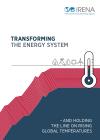
-
-
IRENA (2019), Transforming the energy system – and holding the line on the rise of global temperatures, International Renewable Energy Agency, Abu Dhabi.
Copied
/-/media/Files/IRENA/Agency/Publication/2019/Sep/IRENA_Transforming_the_energy_system_2019.pdf?rev=6c5505864f1f4efb81c1f4e4db99c440
Copied
Transforming the energy system – and holding the line on rising global temperatures
In response to the threat of climate change, countries around the world have pledged to invest in low-carbon energy. National plans and investment patterns, however, show a stark mismatch with the pathway to meet the commitments set out in the Paris Agreement, which would keep the rise in global temperatures well below 2 degrees (oC) and ideally hold the line at 1.5oC.
At least USD 95 trillion worth of energy investments are planned worldwide until mid-century. But those plans and related investments are not always channelled toward climate proof systems.
This report from the International Renewable Energy Agency (IRENA) explores two broad future paths: Current Plans (meaning the course set by current and planned policies); and the path for a clean, climate-resilient Energy Transformation.
IRENA’s analysis shows that planned fossil-fuel investments must be substantially redirected, with annual investments in renewables more than doubled for the coming decade. A comprehensive energy transformation can create a better energy system – one capable of ensuring that average global temperatures at the end of the century are no more than 1.5°C above pre-industrial levels. But to make this happen, the pace and depth of investments in renewables must be accelerated without delay, the report urges.
Among other findings:
- Creating a climate-safe system calls for USD 110 trillion worth of investments in the energy sector by 2050, compared to USD 95 trillion currently planned.
- Much of the USD 95 trillion currently planned for investments by 2050 must be redirected from fossil fuel investments to clean technologies.
- Renewables – including power generation, end-use applications and biofuels – would account for USD 27 trillion worth of energy transformation investments by 2050.
- Compared to current plans, the transformation would create 7 million more jobs and boost global GDP by 2.5%.
See also the digital story: Holding the line on rising global temperatures





